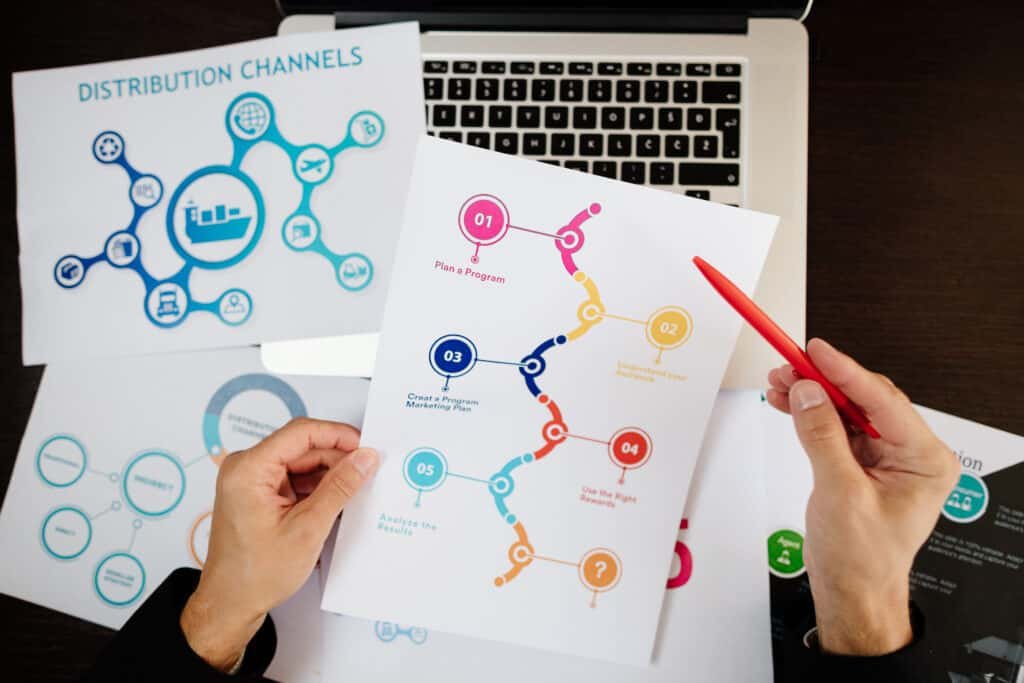
“Agile product development is a framework for managing complex products. Agile approaches are focused on the business value of the features and how to achieve it at the earliest stage possible.”
Agile development is a product development process that has been around for decades. It was created as an alternative to the traditional waterfall project management model, which can be rigid and slow. Agile Product Development provides many benefits over other methods, such as; it’s flexible, iterative and incremental. We will cover what agile product development is and why it is important in this article!
Jump Ahead To :
What Is Agile Development ?

Agile Product Development is a process that can be implemented when developing new products. In contrast with the project management methods, the aim of this approach requires ongoing collaboration between all team members and stakeholders throughout the entire lifecycle of a product. That’s why it became popular with companies who want to increase their chances of introducing successful products into a competitive market or improve existing ones through more frequent releases using shorter iterations.
As mentioned before, agile methodologies are not only used by programmers but also for other professions involved in creating your final product, such as designers, testers. This means you don’t have to be a developer to appreciate agile.
It is important for us agile enthusiasts to understand that agile product development doesn’t only mean software and apps. Still, it can also apply in other domains such as manufacturing, architecture or even the music industry! While agile methodologies help teams and organisations deliver better products faster than ever before, we must not forget its limitations once you become more specialised in your project requirements.
The key aspect of agile product development is collaboration since it requires constant feedback from all stakeholders throughout the entire process. This allows them to express their concerns early on so they know any risks ahead of time instead of at later stages where issues might already arise due to lack of communication. This way, everyone involved has equal rights over the product, and agile teams prefer to work in cross-functional, self-organised groups rather than rely on a hierarchical structure.
The agile manifesto is an agile philosophy that came into existence around 2001 when 17 software professionals discussed the best way of developing products for their clients by considering all stages of development within one single process instead of two different design and programming approaches were separated until the testing phase. These men gave birth to a manifesto that consists of four values:
- Individuals and interactions over processes and tools.
- Working software over comprehensive documentation.
- Customer collaboration over contract negotiation.
- Responding to change over following a plan.
Since then, the agile community has evolved so much, but these are still considered agile principles we should follow throughout our entire agile product development process.
So, agile is all about your team members working closely together throughout the entire lifecycle, but how do you know for sure that agile methodology fits best with your organisation or company? The truth is there’s no silver bullet when it comes to agile since every single one of us has different needs and requirements depending on our business goals. That’s why agile was born out of the programming world, and its principles are universal so that they can be applied across other industries too!
As mentioned before, agile methodologies rely heavily on communication between everyone involved in creating your final product. This makes them particularly good at dealing with changes during the early stages, where issues might arise more easily than later down the road when schedules are set in stone, and no room for further modifications exist. That’s why agile methods are best suited for projects which require frequent updates and modifications over longer periods, such as agile product development or even agile fashion design!
What Is The Focus Of Agile Product Development?

Agile Product Development (APD) is a software development method that uses agile principles and practices. It works well for complex products with changing requirements, such as new websites or mobile apps. APD focuses on delivering value to customers by iteratively building working prototypes in short cycles called sprints.
The following are the key characteristics of agile product development:
– Focus on customer values; deliver early and often through iterations
– Flexible plans based around agile user stories written from customers’ perspectives
– Build working products at the end of each iteration/sprint cycle
– Collaboration between cross-functional teams throughout all phases of the project life cycle (requirements gathering, design, coding, testing)
– Incremental development
– Frequent releases, often daily or weekly
– Working software is the priority over comprehensive documentation.
– Simplicity of design and agile principles are integral to agile product development methods. Agile product development aims for teams to think about simplicity instead of adding extra features just because they can be added at a later time frame in the life cycle. If something doesn’t add value, it should not be included in an agile environment.
Teams that focus on incremental delivery will build out functionality until enough working pieces are ready for release into production. Customers can test it and provide feedback before additional iterations happen towards building more components onto existing implementations. This allows teams to learn from customer experience, so agile product development teams will have information about what customers want and need when new features get added.
Benefits Of Agile Product Development

The agile approach offers many benefits for product development. Benefits include higher quality, reduced risk of failure due to lack of requirements clarity and better communication among team members.
– Agile encourages teams to build products incrementally over short timeframes that are driven by users’ needs.
– The agile process is iterative, which means that problems can be identified early on in the development cycle as well as hopefully fixed before it requires a large amount of work from other team members or stakeholders who may not be able to provide any additional help if there’s already too much backlog. This will reduce rework and overall project costs down the road when changes need to be made because those mistakes were allowed at the first iteration stages instead of later ones where more people and resources would be needed to fix them.
– Because agile development is iterative, it allows for frequent testing of the product with users or internal stakeholders before significant investment into that particular feature has been made. This means that if there’s a problem, then time will not have been wasted on building something out only to find out later on as well as allowing for better customer feedback since they can see progress more easily than they could in the waterfall where no working software may have been produced until much further down the project timeline.
Another big benefit of agile methodologies is that you don’t need specialised tools for your team members to communicate effectively. All communication happens face-to-face, thus reducing overhead costs involved in acquiring and maintaining any agile software.
Steps to achieving an agile success
To achieve agile success, companies need their teams to follow these steps:
– Gather requirements from customers/users and other sources such as sales staff who hear what customers want most often when buying products similar to the ones being developed.
– Collaborate across teams to ensure that agile processes are communicated effectively and implemented correctly to achieve the highest value for customers/users and internal stakeholders.
– Use agile frameworks such as SCRUM or XP, which have been designed with adaptability in mind so they can be applied successfully under different circumstances, within various development contexts and throughout all stages of product life cycles no matter what industry you’re working in.
– Identify risks early on by creating a risk log together, which will help identify areas where unexpected problems might arise along with potential solutions before they happen. This allows them to be mitigated beforehand instead of after the fact when there’s more time wasted due to having invested effort into something that didn’t work out.
– Hold agile retrospectives to identify what went well and what did not go so well with the agile process to make changes if needed for the next iterations. It will allow companies to continuously improve their agile processes based on how teams are using them instead of simply trying something once only to find that it doesn’t resonate with everyone or is too difficult/impossible to implement due to real-world constraints outside of a lab environment where no actual customers are using the product that’s under development.
Various Agile Product Development Tools
We Have agile teams, agile backlogs and agile plans, all tools used to keep agile development projects on track.
Agile team members work together in an iterative process rather than sequentially to complete tasks within a project. This allows for changes throughout the agile product lifecycle because conditions can change at any time during this continuous developmental approach.
The agile backlog is created by the Product Owner who represents stakeholders of the business area being developed or enhanced by developers working with them through iteration upon iteration until they have completed their goal while continuously delivering value back into production so that everyone can stay updated regarding new features or functionality available for usage.
The agile plan is also created based on input from multiple sources, including users, customers, management, and marketing departments. It is a road map showing agile team members, their tasks and the order in which they are to be completed.
The agile product development tools We Have all exist within an overall agile framework that enables teams to collaborate more efficiently while being part of agile scrum or agile kanban. This allows for constant improvement throughout each iteration so that value can keep flowing back into production at every stage rather than bottling up until everything has been implemented. By continually working together on delivering value, everyone wins!
Tips For Agile Product Development
– Agile project management should be utilised by any good developer team because it emphasises communication and collaboration, which lets everyone on the team know what they need to do without micromanagement from managers or developers giving them work packages with no context.
– A/B testing helps determine how users interact with certain features to see if those features are really valuable or not before actually building out an entire feature set – this helps agile product development teams save time and resources.
– Continuous integration is the process of merging code changes with a central repository early and often so you can find errors sooner rather than later – this allows agile product development managers to build higher quality products faster while having more insight into which features are valuable.
When using agile frameworks, there should be at least one business analyst on your agile team who can work closely with developers to create acceptance criteria for user stories and prioritise them according to their value or ease of implementation. This ensures that everyone knows how they get paid (how much) before starting any tasks related to new requirements/stories from customers/users because it greatly reduces rework when implementing new ideas.
– Set goals specific to your organisation’s needs by working closely with stakeholders throughout the project cycle. Be sure these goals are measurable, so you know when they have been reached successfully. For example, create performance objectives instead of generic “improvements.”
– Use an incremental approach rather than comprehensive planning – this allows for flexibility while maintaining control over priorities and deadlines within each iteration.
– Keep your agile product development team small and agile. Having too many people on the agile product development project slows it down, while a smaller agile scrum team can be more nimble in their approach to getting things done.
Wrap Up
So, now that you know what agile is all about, it might be a good idea to test the waters with agile methodology in your own company by trying out one of its many flavours available today since they can become quite different from each other depending on the project requirements. If you feel like agile suits your needs perfectly, then great, but if not, don’t worry because there are plenty more methodologies where those came from!






